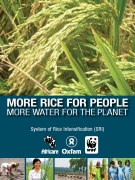/topics/irrigation
Irrigation
A turning point in water saving technologies in north Gujarat’s groundwater socio-ecology – a report by Carewater INREM foundation
Posted on 08 Aug, 2010 10:13 PM The study analyses the changes in farming system and socio-economic impacts at the household level through “before-and-after” (longitudinal) comparison of adopters an
The study analyses the changes in farming system and socio-economic impacts at the household level through “before-and-after” (longitudinal) comparison of adopters an
Inland fishery in a traditionally vegetarian state: A Gujarat story by CAREWATER
Posted on 07 Aug, 2010 08:12 PMMore rice for people - More water for the planet - A WWF-ICRISAT report about System of Rice Intensification
Posted on 02 Aug, 2010 02:08 AM This project report by WWF-ICRISAT begins by highlighting the importance of rice as a major source of calories for half the world’s population and also as the single largest source of employment and income for the rural population.
This project report by WWF-ICRISAT begins by highlighting the importance of rice as a major source of calories for half the world’s population and also as the single largest source of employment and income for the rural population.
It makes connections between rice production and its impact on the environment and argues for need to adopt techniques such as System of Rice Intensification (SRI) to improve produce and reduce the damage to the environment.
For example, current practices at genetic uniformity can make crops more vulnerable to pests and diseases. They are also wasteful of increasingly scarce and costly resources such as water and fossil fuels. Heavily fertilised, continuously flooded rice fields produce greenhouse gases that contribute to global warming, and misuse of inorganic fertilisers and agrochemicals results in soil and water pollution. Evidence indicates that there has been a gradual slowdown in the yield gains of rice in many countries.
Private investment in groundwater irrigation: Do the public institutions matter? - The case of West Bengal
Posted on 01 Aug, 2010 01:34 AMThis paper by Centre for Studies in Social Sciences and Jadavpur University, aims at explaining the factors that determine private investment in groundwater irrigation in West Bengal. It also addresses the issues pertaining to institutional arrangements, particularly provision of facilities by the government. The study, largely empirical in nature, is based on data collected from surveys conducted in close to one thousand moujas (villages) spread across the major agro-climatic zones in West Bengal. It begins with a descriptive account of the changes in the agricultural scenario in West Bengal over the last thirty years. The research questions are discussed and the econometric methodology presented.
Vaidyanathan Committee Report on Pricing of Irrigation Water - Planning Commission (1992)
Posted on 31 Jul, 2010 02:28 PMThe Vaidyanathan Committee was set up by the Planning Commission, to review the existing water rate structure and the extent of subsidy in Government and Public Sector irrigation projects. It suggested the norms for fixing water rates, cost escalation on the Operation and Maintenance (O&M) component of economic water rates, conversion of volumetric supply of water rates from crop-wise and area-wise water rates for different agro-climatic zones. Based on these, it suggested organizational measures including a mechanism for efficient recovery ofeconomic water rates and operating controls for ensuring levy of appropriate irrigation water rates by the States.
Construction and Maintenance of Minors: A manual by Uttar Pradesh Water Sector Restructuring Project
Posted on 29 Jul, 2010 11:25 PMThis manual by the Uttar Pradesh Water Sector Restructuring Project - UP Department of Irrigation, written for Water User's Associations (WUAs), provides guidelines for restoring under-performing minors (irrigation channels which carries water to the fields) in the state, to their original design characteristics before the maintenance and management of minors is transferred to the WUAs. This is a prerequisite for making the use of irrigation water economical and efficient, and for introduction of volumetric system of water flow.
Analysis of surface runoff and baseflow at Tambarapani basin – A research report by National Institute of Hydrology
Posted on 24 Jul, 2010 09:12 PMThe report presents the analysis of surface runoff and baseflow carried out for the Ariyanayakipuram anicut, Tambarapani basin, Tamil Nadu for a period of 13 years (1983-95). The hydrological behavior of catchments is a very complex phenomenon and is controlled by a large number of climatic and physiographic factors that vary in time and space. The analysis shows that the contribution of baseflow at Ariyanayakipuram anicut was observed to be more.
Hydrological soil classification in Sher-Umar river doab in Narmada basin – A research report by National Institute of Hydrology
Posted on 24 Jul, 2010 05:35 PMThe report deals with hydrological soil classification in Sher-Umar river doab in Narmada basin. The study and classification of soil has in the past been undertaken by engineers and agriculturists who have confined themselves to those soil properties and materials in which they had a special interest. The soils have also been studied by geologists, but the geological description of an area does not include the information required by soil scientists. The classification designed by soil users have tended to be of limited value to others as they were designed to serve a specific and limited purpose.
Planning of crop and water management practices using weekly rainfall data - A research report by National Institute of Hydrology
Posted on 24 Jul, 2010 10:40 AMThe report presents a methodology for planning of crop and water management practices using weekly rainfall data.
Estimation of soil erosion and sediment yield in Karso catchment of Barakar basin in Jharkhand using ANSWERS model - A research report by National Institute of Hydrology
Posted on 24 Jul, 2010 10:21 AMThe report presents an estimation of soil erosion and sediment yield for the Karso catchment of Barakar basin in Jharkhand using ANSWERS model. Quantitative assessments of runoff and soil erosion are needed for proper management of land and water resources.




